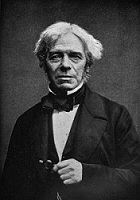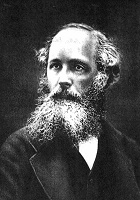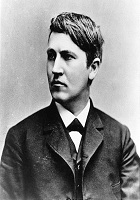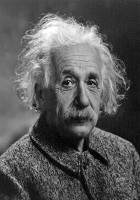Researchers
Many could be mentioned here, but these four opened up the most important doors:
 Michael Faraday
Michael Faraday
Faraday, the greatest experimental researcher mankind ever brought forth, was born in Surrey in 1791. His family was poor and they were members of a small Christian sect which strongly influenced the way he interpreted nature. He received only little formal schooling and had to start earning his own living early. At the age of 14 he was apprenticed with a book-binder and he started to read the books brought for binding. Electricity was what interested him most.
As early as 1821 he took up investigating electricity and magnetism in a way that was to revolutionise physics. He conceived of electricity as a vibration or force emitted from a source with an electric potential. In 1831 he discovered the phenomenon of induction: an electric current is induced in a coil of wire if a magnet is introduced or withdrawn. In 1846 he suggested that electric or magnetic field lines might serve as the medium of propagation for light. By 1850 he had developed a completely new concept of space and forces. According to this concept space is a medium that supports electric and magnetic forces. Energy is not concentrated in the particles our world is made of, but in the space surrounding them. The field theory had been born. Faraday was the first one to recognise the connection between electricity and magnetism, and this, unexpectedly, led to a new explanation of light. A light wave is created whenever an electric charge accelerates or decelerates. In Faraday’s view each charge creates a space or field in which every other charge is subject to an attracting or repelling force. If there are several charges the electric field becomes a complex network of interconnecting lines. According to Faraday’s theory the universe is criss-crossed by a cosmic network of electric field lines. He turned this static view into a dynamic one by visualising the field lines as elastic bands. His revolutionary theory of light broke the fetters of the materialistic world view of his time, rendering him the decisive figure in the history of light during the 19th century.
The hypothesis he eventually proposed radically changed the scientific view of light, initiating a turning point in scientific thought and in the western concept of light. According to his understanding, a physical force field, and not substance or matter, represents the true nature of the universe. And this force field – unlike the ether – reaches from one end of the universe to the other.
 James Clerk Maxwell
James Clerk Maxwell
James Clerk Maxwell James Clerk Maxwell was born in Edinburgh in 1831. After an excellent formal education he studied mathematics and physics, completing his studies in Cambridge. In 1856 he was appointed professor in Aberdeen and from 1860 onwards he taught at King’s College in London. He died in Cambridge in 1879.During the 19th century the scientific understanding of reality experienced some profound changes. The culminating point of this revolution was Maxwell’s mathematical treatment of light. Until then, science had postulated a mechanistic universe formed by matter in movement, but Faraday and Maxwell revolutionised this view of the world. During the preceding hundred years, new forms of energy – of an electrical and mathematical nature – had been explored, and now the time had come for the greatest achievement of all: the electromagnetic concept of light. Maxwell’s paper “A Dynamical Theory of the Electromagnetic Field” published in 1864 was the crucial step representing a mile stone in the history of science. In it, he combined all the scattered data on electricity and magnetism into a single system of eight equations.
From the first serious experiments on electricity and magnetism up until the insights of Maxwell electricity and light had been two completely separate subject matters. What could these two natural phenomena have in common? Everything, was the answer that Maxwell and Faraday gave. It must have been a tremendous revelation when Maxwell worked out this new concept of the structure of reality. It became clear that objects are not surrounded by a material ether but by an electromagnetic field. Faraday’s magnetic field lines are everywhere in space; they surround and even penetrate all objects. With this new concept, all electric and magnetic phenomena can be explained.
In the course of his analyses Maxwell came up with an equation for the electromagnetic field that corresponded with the equation for the propagation of sound waves. And what was more, on the basis of his equations the speed of light could be correctly predicted. Eventually he came to the conclusion that magnetism and light are effects of the same substance and that light is an electromagnetic disturbance that propagates in space according to the electromagnetic laws. Thus light, electricity and magnetism became intimately connected. Light had turned into an electromagnetic wave whose oscillations cause ripples in space.
Maxwell came to the conclusion that the electromagnetic field represents a reservoir of energy. The energy resides in the electromagnetic field, in the space surrounding all electrified and magnetic objects as well as in the objects themselves. According to Maxwell the field possesses energy.Why does the filament of a lamp turn hot and start to glow? Not because of the current flowing through it, but because field energy from the surrounding space enters the filament as soon as a current flows through it. Energy flows around and into conductors, but not through them. Basically now the question arose whether everything might be field energy organising itself into different forms. It was Einstein who revealed the nature of the relationship between energy and matter.
 Thomas A. Edison
Thomas A. Edison
Edison was self-educated and had acquired his knowledge during long years of secluded reading – probably due to the deafness he was afflicted with from the age of 12. He worked his way up from a casual labourer to a highly qualified technical entrepreneur.
When he first got involved with electrical light in 1878, he concentrated on the improvement of the light bulb. One of the problems was that the filament had to be heated to extremely high temperatures in order to give light. White heat is only generated at temperatures of 2500 °C and more.Another problem was the electric resistance of the filament. This is the material property that is responsible for the heat – and therefore the light – that is generated when an electric current flows through the wire. An electric current is a flux of electrons that are pushed through a wire by an electric potential. On their way they are slowed down by the atoms of the wire. At each encounter with an atom the energy of the moving electron is transformed into oscillation or warmth. These oscillations affect the electromagnetic field so strongly that light is produced. The electric resistance has an important practical aspect, as Edison astutely recognised. Low resistance allows a strong current, comparable to a smooth road that allows more cars to drive through than a rough one. He planned to connect his lamps to a network supplied by a central power source. With strong currents a lot of energy would be lost in the connecting wires in the form of useless warmth. Therefore he planned to use weak currents and lamps with thin filaments of high resistance. Each one of them was to have its own electric circuit so that the others would still work if one of them burnt out.
Thus, he started searching for a filament with high resistance and high heat stability which would give an intense and bright light without wearing out too fast. He tried platinum and other metals and found all of them unsuitable. So he tried his luck with carbon and in 1879 discovered a filament that met all his requirements. He used a loop of cotton thread that had been baked in an oven until only a thin strand of carbon remained. This proved to have a high electric resistance.To prevent oxidation, the filament was inserted into a glass bulb which was evacuated and sealed. The first carbon fibre lamps burned for forty hours. They were very fragile, so Edison started searching for tougher filaments. He tested all kinds of materials containing carbon – different kinds of wood, cork, silk, coconut fibres, human hair and various other materials. Lamps containing carbonised cardboard achieved a life span of 170 hours. Carbonised bamboo proved even more durable. Bamboo was used up until 1889 when new and better materials were discovered. For general usage, Edison’s incandescent lamps were tested in London’s underground before the system was introduced in a part of Manhattan in 1882.
 Albert Einstein
Albert Einstein
Einstein was born in Ulm in 1879. He was not very good at school, but even as a teenager he was able to understand difficult mathematical problems; he taught himself Euclidian Geometry when he was only twelve years old. At 15 he left school to live with his parents in Milan for a year and then finished his “Abitur” in Switzerland. He studied at the Swiss Federal Institute of Technology Zurich, but often missed classes and lectures. Instead he studied physics by himself at home. In 1900 he took his final examinations. Afterwards he applied for an assistantship, but was rejected by all the universities. From 1902 to 1909 he worked as a third-class technical expert at the patent office in Bern. This task was not very demanding so that he could devote his spare time to research. In 1905 he published his “Theory of Special Relativity”. In 1907 he worked out the “Law of the Equivalence of Mass and Energy” which is expressed in the formula “e = mc2”. Starting in 1909 he worked as a professor of theoretical physics in Zurich and Prague and was then appointed director at the Institute of Physics in Berlin. Between 1914 and 1916 he developed the “General Theory of Relativity”. In 1921 he was awarded the Nobel Prize. In 1933 he emigrated to the USA and worked as a professor in Princeton. There he died on April 18, 1955.
Einstein started out with a mental experiment. Probably he had already contemplated the impossible when he was only 16 years old. If one is running behind a light wave at the speed of light, the wave should appear immobile. But this, he thought, does not seem to happen! He had come across a fascinating paradox, one he could contemplate but did not find an answer to. One can imagine running at any speed and accompanying any moving object. But with light it is different: its movement seems to be of a special kind. Light without movement? Impossible! But by thinking the impossible he brought about a revolution. For almost ten years he grappled with this riddle while the scientist in him matured. Like the grain of sand in the oyster, the nature of light was the irritating question that caused the pearl of the theory of relativity to grow. In 1905 he finally found a partial answer to the mystery of light.
Einstein was not hampered by the traditional thinking of classical physics and could appropriate new concepts with admirable ease. Other scientists were unable to rid themselves of the mechanistic concept of light and of the framework of absolute space and absolute time. Throughout the 19th century the scientific view of light had been that of a pulsation of the universal, material ether – a concept that proved as persistent as it was wrong. Einstein was a pure theoretical thinker and thus opened up new ways of thinking about old problems of light, ether, space and time.
His theory of relativity has two revolutionary aspects: the complete collapse of the ether hypothesis and the special significance of the speed of light. Time is relative, i.e. two events that one observer sees happening at the same time, do not have to coincide if seen by a different observer. Besides, time moves the more slowly, the faster you go. Length also is relative, i.e. the faster an object moves, the shorter it appears to a resting observer. And mass is relative as well, i.e. the faster an object moves, the larger its mass. One of the consequences of this fact is that there can be no observer riding with a light wave, for he would be shortened to the length of zero, his mass would be infinite and for him time would stand still. Also, Einstein declared that light consists of small particles, the so-called photons.
The more photons light contains, the brighter it is. And the more energy the photons contain, the higher the frequency of the light. Copernicus had banished human consciousness from its traditional home on earth to the sun – which turned out to be just an insignificant star in the Milky Way. Now no material centre of creation could be found any more, everything exists on an equal footing.
Einstein went one step further: Now there wasn’t even a place of rest any more, but everything everywhere was equally in motion. Through Copernicus place became relative, through Einstein motion became relative. Together, they liberated human consciousness. Only one thing remained constant: the speed of light. Everything around it was toppled.
“Fifty years of intense contemplation have not brought me closer to an answer to the question: what are light quantums? Today of course every fool thinks he knows the answer. But he is deluded.”
Albert Einstein

